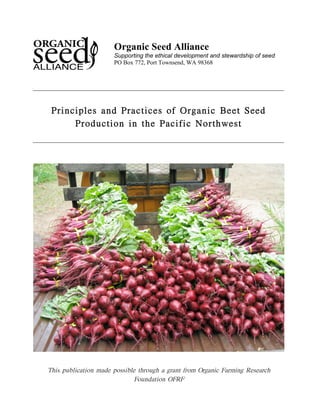This document provides information about organic beet seed production, including:
1) It discusses two methods for producing beet seed - the "seed-to-seed" method, where beet seed is planted and overwintered in the field, and the "root-to-seed" method, where beet roots are harvested, overwintered, and replanted to produce seed.
2) It describes the ideal climate and soil conditions for beet seed production, noting cool spring temperatures are best for vegetative growth while cooler, dryer summer weather supports pollination and seed development.
3) It explains the beet lifecycle as a biennial plant, producing leaves the first year and flowering the second year after a
















![Organic Seed Alliance · www.seedalliance.org
17
BNYVV exists in the parasitic soil fungus
Polymyxa betae. P. betae survives in soil and in
plant debris. High soil moisture and warm soil
conditions make P. betae more likely to infect
plant roots, vectoring BNYVV.
To control BNYVV: 1) Plant early to avoid warm
soil temperatures, 2) avoid saturating soils, 3)
practice crop rotations, and 4) use varieties with
horizontal resistance (current varieties with single
gene resistance appear to be failing).
Nutrient deficiencies:
Crown or heart rot – boron deficiency
Boron is an immobile plant nutrient. When there
is not a sufficient supply available for plant
growth, deficiency symptoms will appear in fast
growing tissues. These symptoms include young
leaves with a black or brown appearance, and
necrosis of the crown.
If soil tests indicate low boron status, boron may
be added as an organically approved borax at least
1.8 lbs / acre (2 kg/ha). Deficiencies are more
common in coarse-textured soils. Even if present,
boron may not be plant-available if the soil is too
alkaline.
References and Resources
Department of Horticulture and Crop Science,
The Ohio State University. Undated. Vegetable
seed production [Online]. Available at:
http://extension.osu.edu/~seedsci/vsp01.html
(verified 24 Aug 2009).
Draycott, A. P. 1991. Sugar Beet. New York: J.
Wiley and Sons, Inc.
George, R. A. T. 1999. Vegetable seed
production. New York: CABI Publ.
Du Toit, L. J. 2007. Crop profile for table beet
seed. WSU Pub #MISC0356E [Online]. Available
at:
http://www.ipmcenters.org/cropprofiles/docs/WA
beetseed.pdf (verified 24 Aug 2009).
Goldberg, N. P. and E. L. Shannon. 2006. Curly
Top Virus. NMSU Guide H-106 [Online].
Available at: http://aces.nmsu.edu/pubs/_h/h-
106.html (verified 24 Aug 2009).
Goldman, I. L. and J. P. Navazio. 2003. History of
breeding of table beet in the United States. Plant
Breeding Reviews. 22:357-388.
Harveson, R. M. 2007. Cercospora Leaf Spot of
Sugar Beet UNL Pub G1842 [Online]. Available
at:
http://www.ianrpubs.unl.edu/epublic/pages/public
ationD.jsp?publicationId=840 (verified 24 Aug
2009).
Harveson, R. M. 2007. Rhizoctonia Root and
Crown Rot of Sugar Beet. UNL Pub G1841
[Online]. Available at:
http://www.ianrpubs.unl.edu/epublic/live/g1841/b
uild/g1841.pdf (verified 24 Aug 2009).
Holly Seeds. 2006. Sugar Beet Production Manual
[Online]. Available at:
http://www.beetseed.com/agronomy/ProductionG
uide.pdf (verified 24 Aug 2009).
Maynard, D. N. and G. J. Hockmuth. 1997.
Knott's Handbook for Vegetable Growers. New
York: J. Wiley and Sons, Inc.
Parry, D.W. 1990. Plant pathology in agriculture.
Cambridge: Cambridge University Press.
Schwartz, H., L. W. Panella, M. A. Brick, and P.
F. Byrne. 2007. Fusarium Wilt & Yellows of
Sugar Beet & Dry Bean. CSU Crop Series 2950
[Online]. Available at:
http://www.ext.colostate.edu/PUBS/crops/02950.
html (verified 24 Aug 2009).
Whitney, E.D., and J.E. Duffus. 1986.
Compendium of Beet Diseases and Insects. St.
Paul, MN: APS Press.](https://image.slidesharecdn.com/zwv250-141002134513-phpapp02/85/The-Principles-and-Practices-of-Organic-Beet-Seed-Production-in-the-Pacific-Northwest-17-320.jpg)

